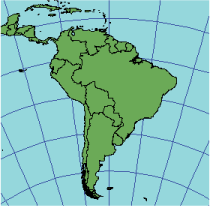Description
This conic projection can be based on one or two standard parallels. As its name implies, all circular parallels are spaced evenly along the meridians. This is true whether one or two parallels are used as the standards.

Projection method
Cone is tangential if one standard parallel is specified and secant if two standard parallels are specified. Graticules are evenly spaced. Meridian spacing is equal, as is the space between each of the concentric arcs that describe the lines of latitude. The poles are represented as arcs rather than points.
If the pole is given as the single standard parallel, the cone becomes a plane and the resulting projection is the same as a polar Azimuthal Equidistant.
Learn more about the Azimuthal Equidistant projection
If two standard parallels are placed symmetrically north and south of the equator, the resulting projection is the same as the Equirectangular projection. In this case, you must use the Equirectangular projection. Use the Equirectangular projection if the standard parallel is the equator.
Lines of contact
Depends on the number of standard parallels.
Tangential projections (Type 1)—one line, indicated by the standard parallel.
Secant projections (Type 2)—two lines, specified as the first and second standard parallels.
Linear graticules
All meridians.
Properties
Shape
Local shapes are true along the standard parallels. Distortion is constant along any given parallel but increases with distance from the standard parallels.
Area
Distortion is constant along any given parallel but increases with distance from the standard parallels.
Direction
Locally true along the standard parallels.
Distance
True along the meridians and the standard parallels. Scale is constant along any given parallel but changes from parallel to parallel.
Limitations
Range in latitude should be limited to 30°.
Uses and applications
Regional mapping of midlatitude areas with a predominantly east–west extent.
Common for atlas maps of small countries.
Used by the former Soviet Union for mapping the entire country.
Parameters
Desktop
- False Easting
- False Northing
- Central Meridian
- Standard Parallel 1
- Standard Parallel 2
- Latitude of origin
Workstation
Number of standard parallels <1 | 2 >:
Type 1
- Latitude of the standard parallel (DMS)
- Longitude of the Central Meridian (DMS)
- Latitude of the origin (DMS)
- False Easting (meters)
- False Northing (meters)
Type 2
- Latitude of the 1st standard parallel (DMS)
- Latitude of the 2nd standard parallel (DMS)
- Longitude of the Central Meridian (DMS)
- Latitude of the origin (DMS)
- False Easting (meters)
- False Northing (meters)